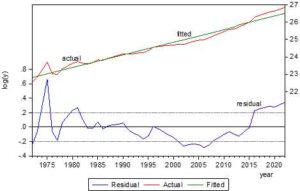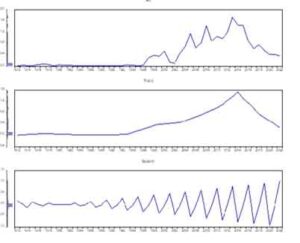By Dr. Debesh Bhowmik
Discussion on Bangladesh became an important theme/issue now a days because of its political change. The small country-Bangladesh and its care taker or Interim government has been remarking on several issues both on economics, social and politics which are debatable and provocation as well as threatening against India. Some of the people of Bangladesh raised slogans against India and they are no longer require India’s economic and political supports. How much Bangladesh economy became self-reliance is hardly questionable. However, this article endeavors to analyze some of the important macro-economic indicators that can justify the progress of the economy so far. Imminent economists treated Bangladesh as an emerging economy and it is developing faster than other countries. Let us analyze the macro indicators one by one.
The GDP of Bangladesh has been catapulting at the rate of 7.26% per year during 1972-2022 significantly which is obtained from the regression equation of trend line given below.
Log(y)=22.736+0.072668t+ui
(399.89)* (38.57)*
R2=0.96,F=1488.407*,DW=0.554,n=51,*=significant at 5% level,y=GDP in million US$.
In Figure 1,the trend line of GDP is shown upward from left to right steadily in the green line where as red line is the actual GDP of Bangladesh. GDP was 6288245867 US$ in 1972 which rose to 46013200000 US$ in 2022.
Figure 1:GDP growth rate

In the cyclical trend line of GDP of Bangladesh during 1972-2022 is shown as monotonically increasing from left to right where no peaks or troughs were found (Figure 2).
Figure 2: Cyclical trend of GDP

The GDP per capita of Bangladesh has been growing at the rate of 5.49% per year from 1972 to 2022 significantly at 5% level which is shown by regression line below. In 1972,it was 90.67 US$ which rose to 2687.89US$ in 2022.
Log(z)=4.621+0.05494t+ui
(70.71)* (25.37)*
R2=0.929, F=643.742*, DW=0.421, n=51,*=significant at 5% level, z=GDP per capita in US$.
In Figure 3, the trend line of GDP per capita of Bangladesh has been depicted in green line which is steady upward from left to right but in actual GDP per capital the red line showed a few variations.
Figure 3: Trend line of GDP per capita
Above all, the GDP per capita of Bangladesh has a long run cyclical trend which is monotonically increasing pattern as shown in the following diagram (Figure 4).
Figure 4: Cyclical trend of GDP per capita

Value added in Agriculture of Bangladesh has been catapulting at the rate of 3.0% per year significantly from 1972 to 2022 which is shown below. It was 8345497036US$ in 1972 which grew 35977340642US$ in 2022.
Log(ag)=22.682+0.03004t+ui
(1120.92)*(44.809)*
R2=0.97, F=2007.91*, n=51, ag=value added in agriculture in US$,*=significant at 5% level.
Value added in industry of Bangladesh has been growing at the rate of 13.50% per year during 1972-2022 which is seen in regression equation. It was 2287953900US$ in 1972 which catapulted to 1.34721e13 US$ in 2022.
Log(ind)=23.211+0.13505t+ui
(237.62)*(41.73)*
R2=0.97,F=1741.51*,n=51,DW=0.278, ind=value added in industry in US$,*=significant at 5% level.
Even, the value-added in-service sector has been growing at the rate of 12.74% per year during 1972-2022 significantly which is given below. It was 1291016600US$ in 1972 which rose to 2.02709e13 US$ in 2022.
Log(service)=24.166+0.12746t+ui
(330.53)*(52.62)*
R2=0.98,F=2769.31*,n=51,service=value added in service sector in US$, DW=0.171, *=significant at 5% level.
All the value added in three sectors did not show any cyclical trend rather they had steady progress. In the following figure 5 the value added in all sectors have been depicted where service sector leads the economy followed by industry and agriculture respectively during 1972-2022.
Figure 5: Value added of sectors

To analyse inflation rate, let us consider money supply followed by consumer price index. During 1986-2022, broad money supply has risen at the rate of 14.38% per year significantly while consumer price index at 2010=100 had risen only 5.83% per year significantly which implies that money supply and inflation nexus is quite well.
Log(m3)=23.415+0.14381t+ui
(465.21)*(100.14)*
R2=0.99, F=10028.80*,n=37,m3=broad money supply in US$,DW=0.312,*=significant at 5% level.
Log(CPI)=2.320+0.05837t+ui
(108.68)*(95.85)*
R2=0.99, F=9187.28*,n=37,CPI=consumer price index,2010=100,*=significant at 5% level.
Or in other words, one percent increase in M3 per year induced to increase price level by 0.4045 % per year during 1986-2022 which is given below by double log regression equation.This is not harmful.
Log(CPI)= -7.146+0.4045log(m3)
(-43.89)*(70.18)*
R2=0.99,F=4926.23*,n=37,DW=0.305,*=significant at 5% level.
In international trade, Bangladesh is a trade deficit country. The exports of Bangladesh have been increasing at the rate of 9.24% per year significantly during 1972-2022 which is found from the regression equation of the trend line. It was 599990654US$ in 1972 which increased to 46780850616US$ in 2022.
Log(exp)=19.897+0.09246t+ui
(182.13)*(25.54)*
R2=0.93,F=652.67,DW=0.203,n=51,exp=exports of goods and services in US$,*=significant at 5% level.
On the other hand, imports of goods and services of Bangladesh has been increasing at the rate of 8.53% per year significantly during 1972-2022 which is shown by the estimated trend line. It was 8635370833US$ in 1972 which increased to 96157127851US$ in 2022.
Log(imp)=20.597+0.08535t+ui
(358.78)*(44.87)*
R2=0.976,F=2014.05*,DW=0.562,n=51,imp=value of imports of goods and services,*=significant at 5% level.
Both exports and imports have been increasing monotonically although the balance of trade went against Bangladesh from the very beginning and negative trade balance is growing rapidly.
Figure 6: International trade

Total reserves of Bangladesh have grown at the rate of 11.42% per year during 1972-2022 significantly which is recorded in the regression equation given below. It was 270471434.8 US$ in 1972 which rose to 33747202272 US$ in 2022.
Log(reserves)=18.4814+0.1142t+ui
(157.47)* (29.38)*
R2=0.946,F=863.52*,n=51,reserves=total reserves of Bangladesh in US $.,*=significant at 5% level.
The months of imports of Bangladesh reached peak in 2020 of 8.6 months followed by 7.6months in 2016,6.8months in 1993,6.76 months in 2017 respectively and now in 2022 it is fallen to 3.38 months.
Bangladesh trade with India is found as deficit one where Bangladesh balance of trade has been increasing fast, e.g., BOT was -5742.4 million US $ in 2014 which stood -11087.43 million US$ in 2022(Figure 7).
Figure 7: Indo-Bangladesh trade.

Total external debt of Bangladesh has been increasing at the rate of 7.83% per year significantly from 1972 to 2022.The fitted trend line of external debt is given below.Total external debt was 146504255 billion US$ in 1972 which catapulted to 97011656308 billion US$ in 2022.
Log(x)=21.152+0.07838t+ui
(150.80)*(16.86)*
R2=0.85, F=284.54*,DW=0.191,n=51,*=significant at 5% level.x=total external debt of Bangladesh in billion US$.
In Figure 8, green line is the fitted trend line which is upward sloping from left to right and the red line is the actual external debt of Bangladesh.
Figure 8:Total external debt

Actually, there is no cyclical trend consisting of peaks and troughs but the cyclical trend of external debt is monotonically increasing which is shown in Figure 9 below which had obtained by applying STL method of decomposition.
Figure 9: Cyclical trend of external debt

Bangladesh contains huge scope of FDI inflows because FDI inflows as per cent of GDP has been growing at the rate of 11.96% per year significantly during 1972-2022 which is given in the trend equation. It was 0.001431242% of GDP in 1972 which increased to 0.355308724% of GDP in 2022.
Log(FDI)=-5.6006+0.1196t+ui
(-13.67)* (8.81)*
R2=0.61,F=77.73*,DW=0.85,n=51,FDI =foreign direct investment inflows as per cent of GDP,*=significant at 5% level.
In Figure 10, it is found that the fitted line is upward sloping but actual line contains huge ups and downs. Thus, it has cyclical patterns.
Figure 10: Trend of FDI

The actual FDI inflows as per cent of GDP during 1972-1996 were very low followed by steady increase consisting of 12 peaks and 9 troughs. Although in the cyclical trend, it has only 1peak and 1 trough where the upward peak trend started from 1994 and reached peak in 2015, while the seasonal fluctuations widen gradually like v shaped. All these three types of trends have been depicted in the Figure 11 below.
Figure 11: Trends of FDI

The CO2 emission in Bangladesh has been catapulting at the rate of 1.79% per year significantly which is given below. It was 0.218036Kt in 1990 which increased to 0.31Kt in 2022.
Log(CO2)=-1.846+0.0179t+ui
(-29.09)*(10.36)*
R2=0.775,F=107.33*,DW=0.35,n=33,CO2 =co2 emission in Kt,*=significant at 5% level.
The CO2 emission in Bangladesh during 1990-2022 contains cyclical patterns where in the cycles it has 9 peaks and 9 troughs but highest peak is shown in 2019 while in the cyclical trend it contains only one peak and trough where trough was seen in 1992 and peak is seen in 2016.The seasonal fluctuations are shrinking followed by widening with v shaped (Figure 12).
Figure 12:Trends of CO2

The Gini coefficient of Bangladesh has been increasing at the rate of 0.53% per year significantly during 1983-2022.The estimated linear trendline is given below. Gini was 25.9 in 1983 which increased to 31.8 in 2022.
Log(Gini)=3.3202+0.00533t+ui
(89.07)*(3.09)*
R2=0.545, F=13.60*, n=10,*=significant at 5% level
It implies that the inequality in Bangladesh has been rising significantly. It is plotted in Figure 1 where estimated linear trendline is upward sloping and the actual Gini has 3 peaks and two troughs during the cyclical movement.
Figure 13: Gini of Bangladesh

This inequality pattern in Bangladesh can be verified as below.
The income share of bottom 20% has been declining at the rate of 0.353% per year during 1983-2022 significantly which is estimated below. It was 9.7% in 1983 which stepped down to 8.7% in 2022.
Log(L20) =2.2686-0.00353t+ui
(126.86)*(-4.27)*
R2=0.695, F=18.31*, n=10, *=significant at 5% level. L20=national income share of bottom 20% people of Bangladesh.
It is shown in Figure 14 below where estimated line is downward moving significantly.
Figure 14:The trend of L20

Similarly, the estimated linear trend of the national income share of top 20% population has been increasing at the rate of 0.326% per year significantly during 1983-2022 which is given below.It was 35.8% in 1983 which increased to 40.7% in 2022.
Log(H20)=3.6303+0.00326t+ui
(134.66)*(2.62)*
R2=0.462, F=6.88*, n=10, *=significant at 5% level, H20=national income share of top 20% people.
The trendline is found to be upward sloping but the actual line has two peaks and one trough which is seen in Figure 15 below.
Figure 15: The estimated line of H20

The income share difference of the richest 20% and the poorest 20% in Bangladesh from 1987 to 2022 is inverse u type i.e., at first, inequality rises then inequality started to decline which is shown in the Figure 16 which was depicted by applying quadratic regression estimates through time.
Figure 16: The income inequality

Poverty rate as measured by Head Count Ratio with 2.15 $ as the per capita per day income was 37.3% in 1983 which reached peak at 41.9% in 1991 which drastically fell to 24% in 2005 and finally decreased to 5% in 2022.It demands a remarkable achievement in the world in case of poverty elimination programme.
On the other hand, unemployment rate of Bangladesh is steadily increasing with cyclical fashion showing 2.04% in 1984 which increased to 2.91% in 1996,4.32% in 2003,4.426% in 2013,4.372% in 2017 and 5.247% in 2022 respectively which are suffocating to Bangladesh.
Naturally the increase in Human Development Index from 0.58 in 2014 to 0.67 in 2022 is obvious which clearly showed improvement in education and health.
Thus, it is no doubt that the economy of Bangladesh signifies unprecedented growth in most of the sectors during last four decades which were not seen in most of the developing countries. Yet, its political instability and crises dethroned the Hasina government from power.
Source of data-IMF and the World Bank.




